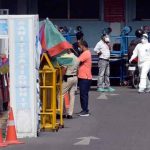India’s coronavirus cases have spiked in recent days, fueling concerns the situation could spiral out of control even as the country starts to reopen after weeks of stringent lockdown.
India is the fourth worst-hit nation in the world, with cumulative infection numbers over 320,000 — behind only the United States, Brazil and Russia, according to Johns Hopkins University data.
Daily reported cases in South Asia’s most populous nation hovered near, and sometimes exceeded, 10,000 per day over the last several days. As of 8 a.m. local time Sunday, there were 11,929 new cases of infection, according to government data.
The high infection numbers also makes India the worst-affected Asian country. Russia, which has the third highest number of cases in the world, is technically part of both Europe and Asia, but most of its major cities are in the European part.
The city of Delhi is said to have become a recent hotspot, with accounts of people struggling to get a hospital bed there and some saying their loved ones died on the doorsteps of medical centers that refused to take them in, Reuters reported.
The deputy chief minister for Delhi told reporters that cases in the national capital region is expected to grow to 550,000 by the end of July, according to the news wire. Delhi reported more than 38,900 total cases as of Sunday morning.
“Last two, three weeks have seen a very significant increase in the number of cases every day,” Arvind Kumar, chairman of the Center for Chest Surgery at Sir Ganga Ram Hospital in Delhi, told CNBC’s “Street Signs” on Friday.
Stop community transmission
The number of infections have risen despite India being in a strict lockdown that began in late March. After a few rounds of extensions, the country finally lifted those measures at the end of May. Still, some states and regions have restrictions in place and many districts are now demarcated into low-risk and high-risk zones. In low-risk areas, economic activity is resuming slowly, while the high-risk zones activities remain restricted.
As a medical doctor, Kumar said he has been appealing to people not to think “everything has returned to normal” — just because the lockdown has officially ended. He cautioned against “moving out and mingling in large numbers.”
He also implored people to wear face masks if they have to step outside and maintain social distancing. “Presume every other person to be infected and maintain at least a meter distance from them,” he said, adding that people should keep washing their hands as frequently as possible.
“If the people-to-people interactions become less in numbers, the transmission will become less and we’ll be able to control the numbers,” he added.
Virus toll on India economy
Nationwide restrictions grounded economic activities around the country, and India’s growth outlook was badly hit.
Gross domestic product grew 3.1% in the three months between January to March — reportedly the slowest pace in at least eight years. The situation is expected to deteriorate further in this quarter.
Still, there are some encouraging signs emerging. Citi economists, Samiran Chakraborty and Baqar M Zaidi, said in a note there was a “sharp” improvement in economic activities in May, compared to the lows seen in April.
“Our weekly activity indicators continue to suggest further improvement in the first week of June as the economy has entered ‘Unlock 1.0’ from 8 Jun,” they said in a note early last week, referring to the early stage of restrictions being lifted.
The geographic concentration of the virus has weakened further, with India’s top 5 states accounting for 68% of daily new cases compared to around 80% in mid-May, according to the Citi economists in their June 8 note.
Maharashtra remains the worst affected Indian state, with its latest cumulative cases at 104,568.
Government data showed on a national level, more than 162,000 people have been discharged, while active cases are over 149,000. The death toll is comparatively low at 9,195.
“Recovery rate and incidence of death both improved a little more this week,” the Citi economists said. “Even as confirmed cases would likely rise further, continued improvement in recovery rate and a low mortality rate would be key factors for the economy to open up as India ‘learns’ to live with the virus.”
Still, reports have suggested that India’s level of testing for the virus remains low and many people are dying without being tested positive for Covid-19. As such, the official death toll may potentially be lower than it really is.





